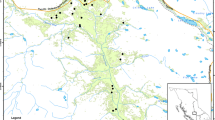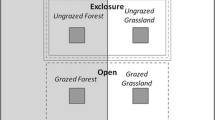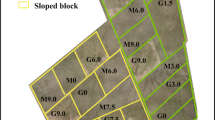Abstract
Pasture lands are an important facet of land use in the northeast United States, yet little is known about their recent diversity. To answer some fundamental questions about the diversity of these pasture lands, we designed a broad survey to document plant species richness using an intensive, multi scale sampling method. We also wanted to learn whether environmental (soils or climate) or land management variables could help explain patterns of species richness. A total of 17 farms, encompassing 37 pastures, were sampled in New York, Pennsylvania, Vermont, Maryland, Massachusetts and Connecticut during July and August 1998. We positively identified a total of 161 different plant species across the study region. Species richness averaged 31.7±1.1 on pastures. Infrequent, transient species that were mostly perennial and annual forbs accounted for ∼ 90% of the species richness. Except for a subjective rating of grazing intensity, land management methods were not good predictors of species richness. Over time, it appears that grazing neither reduces nor increases species richness in pastures. Of the environmental variables measured, only soil P explained a significant amount of the variation in species richness. Soil P was inversely related to species richness at the 1m2 scale. Percent SOM was positively associated with species richness at this scale, although weakly. At larger spatial scales, we suggest that patterns of species richness are best explained by the species diversity of soil seed banks, or seed rain, and stochastic recruitment of these species into existing vegetation.
Similar content being viewed by others
References
Bard, G. E. 1972. Secondary succession on the Piedmont of New Jersey. Ecol. Monogr. 22: 195–215.
Bazzaz, F. A. 1968. Succession on abandon fields in the Swanee Hills, southern Illinois. Ecology 49: 924–936.
Bazzaz, F. A. 1975. Plant species diversity in old-field successional ecosystems in southern Illinois. Ecology 56: 485–488.
Bullock, J. M., Hilt B. C., Dale, M. P. & Silvertown, J. 1994. An experimental study of the effects of sheep grazing on vegetation change in a species-poor grassland and the role of seedling recruitment into gaps. J. Appl. Ecol. 31: 493–507.
Champness, S. S. & Morris, K. 1948. The population of buried viable seeds in relation to contrasting pasture and soil types. J. Ecol. 36: 149–173.
Chippindale, H. G. & Milton, W. E. J. 1934. On the viable seeds present in the soil beneath pastures. J. Ecol. 22: 508–531.
Collins, S. L. & Barber, S. C 1985. Effects of disturbance on diversity in mixed-grass prairie. Vegetatio 64: 87–94.
Fales, S. L., McMurry, S. A. & Weise, W. T. 1993. The role of pasture in northeastern dairy farming: Historical perspective, trends, research imperatives for the future. Pp. 111–133. In: Sims, J. T., (ed.), Agricultural research in the United States: critical review and future perspectives. American Society of Agronomy, Madison, WI.
Forbes, T. J., Dibb, C., Green, J. O., Hopkins, A. & Peel, S. 1980. Factors Affecting the Productivity of permanent grassland; a national farm study. Joint permanent pasture group, Hurley, Maidenhead, Berks.
Foster, D. R., Motzkin, O. & Slater, B. 1998. Land use history as long-term, broad-scale disturbance:regional forest dynamics in central New England. Ecosystems 1: 96–119
Frank, D. A. & McNaughton, S. J. 1991. Stability increases with diversity in plant communities: emperical evidence from the 1988 Yellowstone drought. Oikos 62: 360–362.
Gleason, H. A. & Cronquist, A. 1991. Manual of vascular plants of the Northeastern United States and adjacent Canada. 2nd edition. The New York Botanical Garden, Bronx, NY.
Grime, J. P. 1998. Benefits of plant diversity to ecosystems: immediate, filter and founder effects. J. Ecol. 86: 902–910.
Grime, J.P., Rodgson, J. O. & Runt, R. 1988. Comparative plant ecology: a functional approach to common British species. Unwin Hyman, London.
Hector, A., Schimd, B., Beierkuhnlein, C., Caldeira, M. C., Diemer, M., Dimitrakopoulos, P. G., Finn, J. A., Freitas, H., Giller, P. S., Good, J., Harris, R., Rogberg, P., Huss-Danell, K., Joshi, J., Jumpponen, A., Korner, C., Leadley, P. W., Loreau, M., Minns, A., Mulder, C. P. H., O'Donovan, G., Otway, S. J., Pereira, J. S., Prinz, A., Read, D. J., Scherer-Lorenzen, M., Schulze, E. D., Siamantziouras, A. S. D., Spehn, E. M., Terry, A. C., Troumbis, A. Y., Woodward, F. I., Yachi, S. & Lawton, J. H. 1999. Plant diversity and productivity experiments in European grasslands. Science 286: 1123–1127.
Hooper, D. U. & Vitousek, P. M. 1998. Effects of plant composition and diversity on nutrient cycling. Ecol. Monogr. 68: 121–149.
Knapp, A. K., Blair, J. M., Briggs, J. M., Collins, S. L., Harnett, D. C., Johnson, L. C. & Towne, E.G. 1999. The keystone role of bison in North American tallgrass prairie. Bioscience 49: 39–50.
Leps, J., Osbornova-Kosinova, J. & Rejmanek, M. 1982. Community stability, complexity and species life history strategies. Vegetatio 50: 53–63.
McNaughton, S. J. 1985. Ecology of a grazing ecosystem. Ecol. Monogr. 55: 259–294.
Mellinger, M. V. & McNaughton, S. J. 1975. Structure and function of successional vascular communities in central New York. Ecol. Monogr. 45: 161–182.
Menke, S. & Bradford, G.E. 1992. Rangelands. Agr. Ecosys.Env. 42: 141–163.
Naeem, S., Thompson, L. J., Lawler, S. P., Lawton, J. H. & Woodin, R. M. 1994. Declining biodiversity can alter the performance of ecosystems. Nature 368: 734–737.
Oosting, H. J. 1942. An ecological analysis of the plant communities of Piedmont, North Carolina. Am. Mid. Nat 23: 1–126.
Quartennan, E. 1957. Early plant succession on abandoned cropland in the Central Basin of Tennessee, Ecology 38: 300–309.
Rabinowitz, D. 1981. Buried viable seeds in a North American tall grass prairie: the resemblance of their abundance and composition to dispersing seeds. Oikos 36: 191–195.
Steinauer, E. M. & Collins, S. L. 1995. Effects of urine deposition on small-scale patch structure in prairie vegetation. Ecology 76: 1195–1205.
Stohlgren, T. J., Binkley, D., Chong, G.W., Kalkhan, M. A., Schell, L. D., Bull, K. A., Otsuki, Y., Newman, G., Bashkin, M. & Son, Y. 1999a. Exotic plant species invade hot spots of native plant diversity. Ecol. Monogr. 69: 25–46.
Stohlgren, T. J., Bull, K. A., Otsuki, Y., Villa, C. A. & Lee, M. 1998. Riparian zones as havens for exotic plant species in the central grasslands. Plant Ecol. 138: 113–1125.
Stohlgren, T. J., Falkner, M. B. & ScheIl, L. D. 1995. A modified-Whittaker nested vegetation sampling method. Vegetatio 117: 113–121.
Stohlgren, T. S., Schell, L. D. & Heuvel, B. V. 1999b. How grazing and soil quality affect native and exotic plant diversity in rocky mountain grasslands. Ecol; Appl. 9: 45–64.
Tilman, D. & Downing, J. A. 1994. Biodiversity and stability in grasslands. Nature 367: 363–365.
Tilman, D., Knops, J., Wedin, D., Reich, P., Ritchie, M. & Siemann, E. 1997. The influence of functional diversity and composition on ecosystem processes. Nature 277: 1300–1302.
Tilman, D., Wedin, D. & Knops, J. 1996. Productivity and sustainability influenced by biodiversity in grassland ecosystems. Nature 379: 718–720.
Tracy, B. F. & Sanderson, M. A. 2000. Seed bank diversity in grazing lands of the northeast United States. J. Range Mgmt. 53: 114–118.
USDA, Soil Conservation Service. 1994. Summary report 1992 national resources inventory, Washington, DC.
Whittaker, R. H 1965. Dominance and diversity in land plant communities. Science 147: 250–260.
Author information
Authors and Affiliations
Rights and permissions
About this article
Cite this article
Tracy, B.F., Sanderson, M.A. Patterns of plant species richness in pasture lands of the northeast United States. Plant Ecology 149, 169–180 (2000). https://doi.org/10.1023/A:1026536223478
Issue Date:
DOI: https://doi.org/10.1023/A:1026536223478




